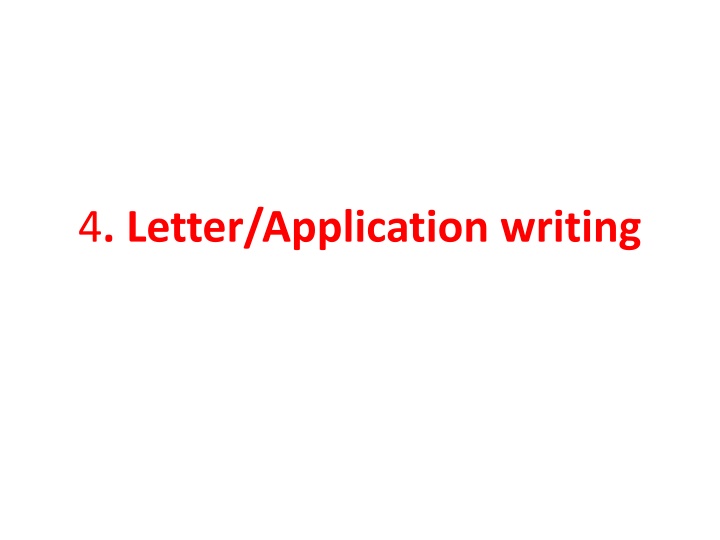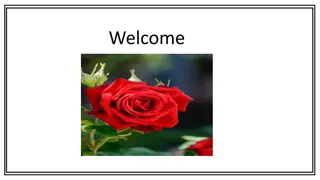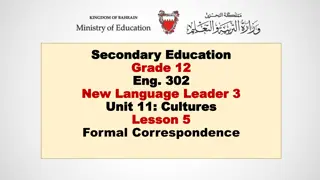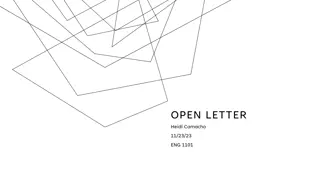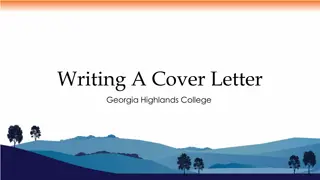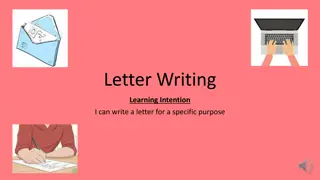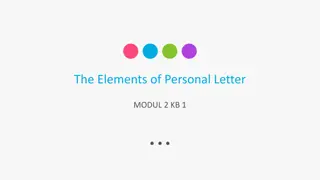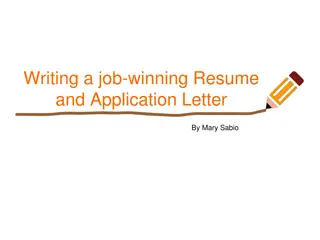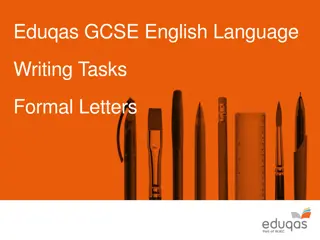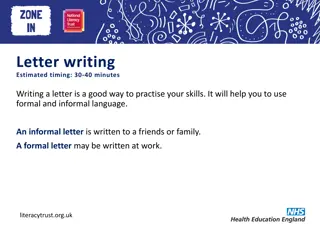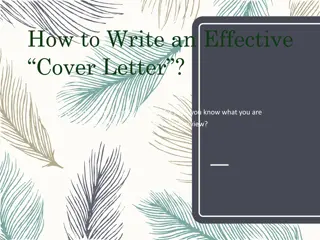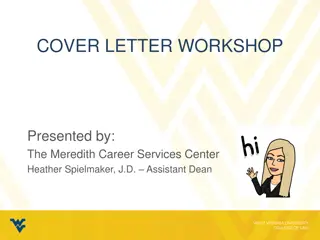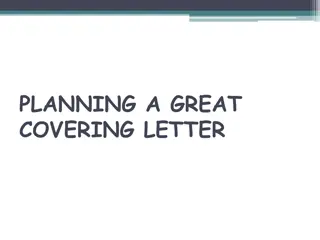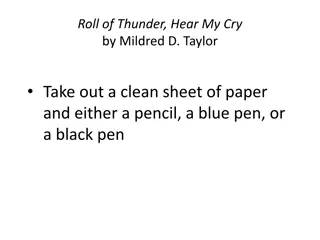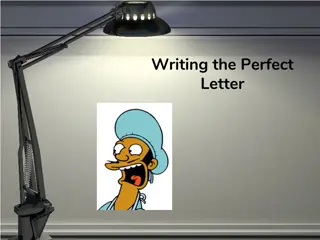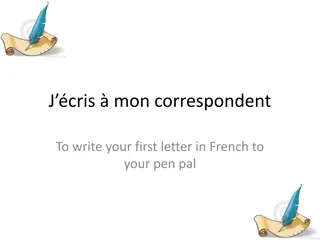Letter/Application writing
Master the art of formal letter and application writing with this comprehensive guide. Learn about the essential components, formats, and different types of letters. Understand the objectives, formats, and criteria for technical writing. Explore the key elements of a letter, from letterhead to complimentary close. Dive into the importance of introduction, body, and conclusion in your writing. Discover optional components like subject lines and enclosure notations to enhance your correspondence skills.
Download Presentation

Please find below an Image/Link to download the presentation.
The content on the website is provided AS IS for your information and personal use only. It may not be sold, licensed, or shared on other websites without obtaining consent from the author.If you encounter any issues during the download, it is possible that the publisher has removed the file from their server.
You are allowed to download the files provided on this website for personal or commercial use, subject to the condition that they are used lawfully. All files are the property of their respective owners.
The content on the website is provided AS IS for your information and personal use only. It may not be sold, licensed, or shared on other websites without obtaining consent from the author.
E N D
Presentation Transcript
Each student will write one formal letter, and one application. The teacher should teach the students how to write the letter and application. The teacher should give proper format and layouts.
Letters Objectives Essential components Formats Different Types Technical Writing Criteria
Letter Objectives Serve as External Communication Reflect on you and your company Constitute A legally binding contract No matter what type of letter you write Follow accepted letter formats Maintain the proper tone Avoid errors
Letter Essentials Letterhead (Writer s) Address Date Reader Inside Address Subject (Optional) Salutation Text (Introduction, Body, Conclusion) Complimentary close Typed name and signature
Introduction Why are you writing? What are you writing about? For example -- As a graduating senior from Delhi, I am interested in information about your MBA program.
Body What exactly do you want to say or ask? Consider using an itemized list for access.
Conclusion What s next? When do you expect a response? Why is that date important? For example -- Your response by April l2 will allow me time to take the GRE and apply to graduate school. Thank you for your help.
Optional Letter Components Subject line All capital letters two spaces below the inside address and two spaces above the salutation New Page Notations Cite your name, the page number, and the date on all pages after page 1. Place either flush with the left margin at the top of subsequent pages or across the top of subsequent pages.
Optional Letter Components Writer s And Typist s Initials Enclosure Notation Two spaces below the typed signature or two spaces below the writer and typist initials Enc: or Enclosure: Show the number of enclosures -- Enclosures (2) Or specify what has been enclosed Enclosures: January Invoice
Optional Letter Components Copy notation A complimentary copy is designated by a lowercase cc: Sincerely, A photocopy is designated by a lowercase pc: Brian Altman Brian Altman Type notation two spaces below the typed signature or two spaces below either the writer s or typist s initials or enclosure notation. Enclosure:August Report Pc: Marcia Rittmaster List the readers names following the copy notation.
Letter Formats Full Block Full Block with Subject Line Modified Block Simplified
Types of Letters Inquiry Cover Good news Bad news Complaint Adjustment Sales
Letters of Inquiry Introduction Clarify your intent in the introduction (why?) Identify the subject matter (what?) Discussion Specify your needs Ask precise questions or list specific topics Will the roofing material cover 150 X 180 ? Conclusion Conclude precisely Provide dated action; explain why
Cover Letters Tells your readers up front what they are receiving Focuses your readers attention on key points within the enclosures Introduction:why you are writing and what you are writing about Discussion: exactly whatyou ve enclosed or exactly whatof value is within the enclosures Conclusion: what you want to happen next, when you want this to happen, and why the data are important
Good News Letters Introduction: explain whyyou re writing and tell whatyou re writing about Discussion: explain exactly what has justified the promotion or the commendation Congratulations Conclusion: what you plan next, when this action will occur, and why the date is important
Bad News Letters Tact is required. Couch the negatives in positive terms. Introduction: begin with a buffer Discussion: states the bad news; preface your assertions with quantifiable proof Conclusion: give your readers an opportunity for future success; provide options to your readers
Complaint Letters Introduction: politely state the problem; include supporting documents Discussion: explain in detail the problems experienced; be specific; document your claims; state what you want done and why Conclusion: end your letter positively; reflect your company s professionalism; include phone number and when you may be reached
Adjustment Letters Aka reponse to letter of complaint 100 Percent Yes Letter (good-news letter) You agree 100 percent with the writer of the complaint letter 100 Percent No Letter (bad-news letter) You disagree 100 percent with the writer of the complaint letter Partial Adjustment Letter May agree with some of the writer s complaints May disagree with other aspects of the complaint
Sales Letters Arouse reader interest An anecdote, a question, a quotation, data Develop your assertions Specify exactly what you offer to benefit your readers or how you ll solve your readers problems Provide data to document your assertions Give testimony from satisfied customers Document your credentials Make your readers act Present an appealing style
Block Format Letter When you use the block form to write a business letter, all the information is typed flush left, with one-inch margins all around. First provide your own address, then skip a line and provide the date, then skip one more line and provide the inside address of the party to whom the letter is addressed. If you are using letterhead that already provides your address, do not retype that information; just begin with the date. For formal letters, avoid abbreviations where possible. Skip another line before the salutation, which should be followed by a colon. Then write the body of your letter as illustrated here, with no indentation at the beginnings of paragraphs. Skip lines between paragraphs. After writing the body of the letter, type the closing, followed by a comma, leave 3 blank lines, then type your name and title (if applicable), all flush left. Sign the letter in the blank space above your typed name. Now doesn't that look professional?
Sample Block Format Letter Your Name Your Address Your City, State, Zip Code Your Phone Number Your Email Date Name Title Organization Address City, State, Zip Code Dear Mr./Ms. Last Name: First Paragraph: Why You Are Writing. Remember to include the name of a mutual contact, if you have one. Be clear and concise regarding your request. Middle Paragraphs: What You Have to Offer. Convince the readers that they should grant the interview or appointment you requested in the first paragraph. Make connections between your abilities and their needs or your need for information and their ability to provide it. Final Paragraph: How You Will Follow Up. Remember, it is your responsibility to follow-up; this relates to your job search. State that you will do so and provide the professional courtesy of indicating when (one week's time is typical). Sincerely, Your Signature Your Typed Name
Technical Writing Criteria Clarity Conciseness Accessibility/Design Audience recognition Audience involvement Accuracy
Before we get into the details of the elements of a business letter, you should know how to present the letter in the proper layout. The layout tells you as how nicely you can present all the elements. You can choose from 1. the standard format, 2. the right-aligned forma or 3. the left-aligned format.
In standard format, the heading comes in the middle. The date is on the right side, followed by the inside address aligned to the left side. The next five elements reference, subject, attention line, salutation and body are aligned to the left. The complimentary close and signature are kept on the right side. Finally, the identification marks, enclosure and the copy notation are brought to the left side.
Now look at the next kind of layout which is called as the right aligned layout. In this one, - all the elements are aligned to the right side, - - - as against the standard format, which is actually a mixture of the right aligned, left aligned and the centered one.
Right Aligned All the elements of a business letter is arranged on the right side. This is very easy to do today - using the word document on a computer - in which you just have to use - the right aligned option, - so it automatically goes to the right side. The detailed layout will look as follows:
Left Aligned Format is the most popular one these days. Reason: it s easy to type on a computer and suits the lazy ones! When it is the standard one, you need to indent, push, center unlike the left-aligned where everything heading, date, inside address, reference, subject, attention line, salutation, body, complimentary close, signature identification marks, and enclosure can be kept on the left side.
As a convention, - the left-aligned one is treated as - American style of letter writing, - while, - the standard model is considered the British style.
Which one of the layouts would you choose? Your choice should depend on the reader of your letter. If you write to an American MNC, you can afford to use the left aligned layout. But if you write to an old, conservative business corporation, - then the standard one should be preferred to be on the safe side. The right-aligned layout normally suits an informal company set-up.
Heading shows the sender/organization s name, full address, telephone, mobile, fax numbers and e-mail id and any other details related to company. Some companies keep their logo/motto and add the hyperlink to their website. They make it readily available in the form of a letter head:
When a letterhead paper is not used, you either align the heading with the left or the right margin depending on the layout you intend to follow.
Use Punctuation one can choose to follow full punctuation, Or use internal punctuation
In an informal set-up, you may choose to type without punctuation mark. Nonetheless, you should use space to distinguish various parts of the address.
